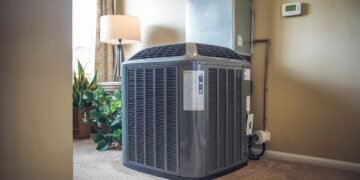If you’re in the market for a new air conditioning system, you must keep a few things in mind. First, select a model that best suits the size of your home, as being under or oversized can cause many issues. Additionally, you need a unit that will work with your climate, as some areas can use a heat pump while others cannot.
Many folks want to take advantage of all the tax rebates and savings available when upgrading. However, the only way you can get these rebates is by getting a highly energy-efficient system. So with energy efficiency in mind, you need to understand the SEER Rating.
How does the Seasonal Energy Efficiency Ratio Impacts You?
Seasonal Energy Efficiency Ratio, or SEER for short, is a sale that’s used to measure the efficiency of an air conditioning system. The manufacturers put the efficiency into a simple number that makes it easy for you to understand. It’s not challenging to find this rating, as it’s placed on a sticker on the front or top of the unit.
The SEER rating was developed back in 1987 to help ensure that marketed units performed at minimum levels. Legislation to protect the consumer made these numbers commonplace and essential to the buying process.
In 1992, it was established that all ac units must have a SEER of at least ten. However, by the time 2006 rolled around, they increased the ranking to 13. Now, if you live in the southern part of the country, you will see ratings of 14 or greater.
It’s estimated by 2023 that the government ratings will require a SEER of 15 or higher. Your SEER rating will help determine how much you can anticipate paying to cool your home. They base this on typical consumption.
So, if you’re setting your thermostat down to 68 degrees, you can’t expect it to be accurate. Remember that numerous other factors go into this equation, such as the space’s square footage, the ductwork’s condition, and windows and insulation.
The Energy Efficiency Rating
While SEER rates central air conditioning units/heat pumps, the energy efficiency ratio is used for window air units. Unlike the SEER, which ranks efficiency by calculating temperatures up to 105 degrees, the EER will only establish efficiency up to 95 degrees.
To simplify things, the EER and the SEER are similar to how an automobile manufacturing company will give you the miles per gallon on a vehicle. You want to know what it will cost to operate that car before you buy it, so the same goes for the AC unit. They try to give you an upfront cost to estimate your expenditure and savings.
Does the SEER or EER Really Matter?
This is a general overview based on average consumption. The standard AC is supposed to be set at 78 degrees to maintain energy efficiency. So, if you keep your unit below that, the estimates will be off.
These numbers are nothing more than guidelines, and you can’t put too much stock into them. If you’re setting your temperature in your home too low, then these numbers will be nowhere near accurate. You can ensure that you’re getting a cost-effective unit that will save you wherever you set the thermostat.
When you shop for your next AC system, you want to strive to get a SEER of 14 or higher. You will find some units on the market that can go as high as 23, but these units will be more costly upfront. As long as you’re reaching the 14-16 threshold, you can ensure your system will be less to operate.
Final Thoughts on SEER and EER Ratings
Do you have a unit you’ve put off replacing because of the upfront price involved? You could be costing yourself more money in the long run. Sure, there’s an upfront expense involved when you replace any system, but the lower energy consumption and lower bills are something you can’t forget. Over time, these newer units will more than pay for themselves in savings.














